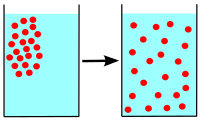
Photo from wikipedia
Abstract Nd-Fe-B based magnets exhibit excellent magnetic properties and are being widely used in high-technology, information, energy and medical fields, etc. Nowadays, with the rapid development of the electric vehicle… Click to show full abstract
Abstract Nd-Fe-B based magnets exhibit excellent magnetic properties and are being widely used in high-technology, information, energy and medical fields, etc. Nowadays, with the rapid development of the electric vehicle industries, Nd-Fe-B magnets have also stepped into a period of rapid development. However, it brings a higher requirement for the magnetic properties at the same time, especially higher coercivity. It is found that the magnetic properties of Nd-Fe-B magnets are related to the components and microstructures of their intergranular phases. Adding some materials by the traditional smelting process can modify intergranular or matrix phases to increase the coercivity of the magnets. The additives evenly distributed in the matrix Nd2Fe14B phases may cause the original composition and structure of Nd2Fe14B phases to be partially destroyed. It also causes not only the remanence of the magnets to be decreased but also a large amount rare earth resources to be wasted. More excitingly, in 2005, a new technology is proposed, named as “Grain Boundary Diffusion”, which effectively increases the coercivity of Nd-Fe-B magnets with a small amount of rare earth additives. And the remanence is usually only slightly reduced. This technology is attributed to modify the composition and structure of grain boundary phases or Nd2Fe14B grains by different material diffusion. In this paper, the research achievements of grain boundary diffusion technologies so far will be introduced. It mainly focuses on the influence of additives on the interface between grain boundary phases and matrix Nd2Fe14B phases, as well as on the intrinsic connection between the microstructures and the magnetic properties. The corresponding diffusion mechanism is also summarized, which serves as data support for the further development of grain boundary diffusion technology.
Journal Title: Journal of Magnetism and Magnetic Materials
Year Published: 2021
Link to full text (if available)
Share on Social Media: Sign Up to like & get
recommendations!